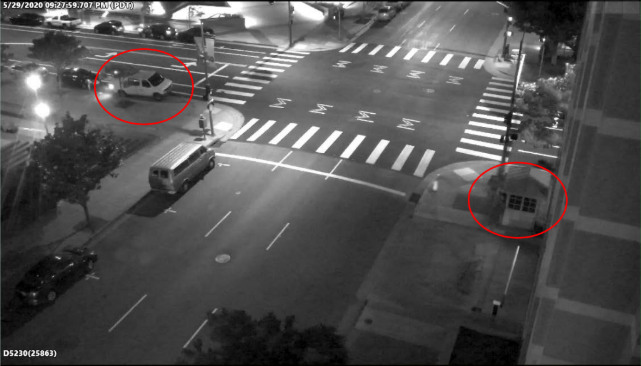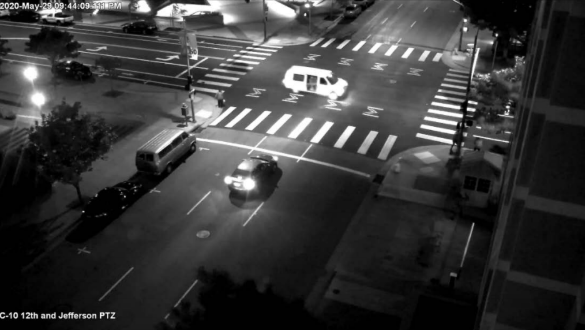Trump administration officials and Republicans in Congress have for weeks played a rhetorical shell game with the American public.
The Black Lives Matter protests that have rocked the country for months, they’ve implied, are deadly: Just look at the federal officer who was murdered during a Black Lives Matter Protest on May 29.
But the murder of Federal Protective Service Officer Dave Patrick Underwood, who was 53 when he was killed in a drive-by shooting, was not committed by a violent protester or rioter, according to authorities.
The alleged killer, Steven Carrillo, wrote a reference to the “boogaloo” movement in blood at the scene of his eventual arrest and reportedly voiced support of a libertarian presidential candidate online. But he did not join the Black Lives Matter protest in Oakland on the night of Underwood’s death.
“There is no evidence that these men had any intention to join the demonstration in Oakland,” said John Bennet, the agent in charge of the FBI’s San Francisco division, referring to Carrillo and the man charged with driving the van used in the drive-by shooting. “They came to Oakland to kill cops.”
And yet, for months, Republicans and administration officials have lumped Carrillo in with the nationwide protest movement.
Sen. Ron Johnson (R-WI), chair of the Senate Committee on Homeland Security and Governmental Affairs, opened a hearing Thursday with the false implication that Carrillo was participating in a protest.
Underwood, Johnson said, was killed while guarding a federal building “during a protest.”
“News reports said the protest involving approximately 8,000 people turned chaotic and violent, as demonstrators smashed windows, looted stores, and broke into a bank a few blocks from where Officer Underwood was on duty.”
After incorrectly saying that Carrillo had killed a sheriff’s deputy “a few days before” — Carrillo’s second alleged killing, of Santa Cruz County Sheriff’s Sgt. Damon Gutzwiller, was actually a few days later on June 6 — Johnson said that the suspect’s “anti-police views drew him to Oakland, where he saw the anti-police protest as an opportunity for more bloodshed.”
While authorities have documented what they allege are Carrillo anti-police views, Johnson’s implications that Carrillo was tied to the protest are misleading. Though a protest did take place nearby the shooting, a security camera still taken seconds beforehand, and cited in the federal criminal complaint against Carrillo, shows the near-empty street where the attack actually took place:

In Facebook posts that the feds allege Carrillo wrote before the shooting, he laid out his plans to hijack the protest and use it for his own ends.
“Go to the riots and support our own cause,” he allegedly wrote. “Show them the real targets. Use their anger to fuel our fire. Think outside the box. We have mobs of angry people to use to our advantage.”
‘Stopping Anarchist Violence’
That follows a pattern for boogaloo supporters. The term refers to armed conflict with the government — internet slang for a second Civil War — and boogalooers have frequented protests of all stripes, from Black Lives Matter marches to anti-mask demonstrations.
Three Nevada men, for example, were charged in June for allegedly planning to use Molotov cocktails at a Black Lives Matter protest in an attempt to encourage an anti-government uprising. But before that, according to prosecutors, they’d considered isolated government buildings as potential targets and recruited people at a protest against COVID-19 orders.
But Republicans have frequently blurred the lines between the boogaloo supporters and the racial justice protests. Sen. Ted Cruz (R-TX) pulled a similar rhetorical maneuver to Johnson’s at a hearing Wednesday on “The Right of the People Peaceably to Assemble: Protecting Speech by Stopping Anarchist Violence.”
In a video montage at the start of the hearing, Cruz put a news clip describing Underwood’s murder next to other clips of protest coverage, implying a connection. Later, Cruz pointed out that Sen. Mazie Hirono (D-HI) didn’t condemn the violence against law enforcement from “rioters.”
“Not a word was said about the murder of federal law enforcement officer Patrick Underwood,” he said immediately afterward.
‘During A Pretty Violent Demonstration’
The administration has also muddied the waters around Underwood’s killing — seemingly seeking to characterize Carrillo as a violent Black Lives Matter protester — for weeks.
At Cruz’s hearing, Acting Deputy DHS secretary Ken Cuccinelli said that Underwood was killed “in the violence following George Floyd’s tragic death.”
Cuccinelli then appeared to use Underwood’s death to attack Democrats, saying that he was disappointed “that select federal, state and local leaders prefer to demonize law enforcement while kowtowing to violent criminals who set fire to our cities, destroy local businesses and target law enforcement officers for harm or even death.”
Six weeks earlier, in a June 26 op-ed, Cuccinelli wrote that while the nation was “appalled” by George Floyd’s death in Minneapolis, “The mayhem that ensued, however, cannot be excused or justified, particularly when it causes the death of another.”
“How do we prevent the death of another Patrick Underwood? We don’t allow lawlessness in our streets,” Cuccinelli wrote.
And during a July 21 press conference largely focused on Portland, the deputy director of the Federal Protective Service — for which Underwood worked as a contractor — explicitly tied his death to protests.
“On May 29, at a federal facility at Oakland, California, during a pretty violent demonstration, two of our protective security officers were shot in a drive-by shooting,” FPS Deputy Director Richard Cline said. “One of those Protective Service officers, Pat Underwood, died of his injuries.”
At best, the administration has sought to equalize the boogaloo movement with “antifa,” a shorthand for anti-fascist demonstrators, which it has lumped together under the banner of violent anti-government extremism.
In late June, in a memo announcing the “Task Force on Violent Anti-Government Extremists,” Attorney General Bill Barr wrote that “We have evidence that anti-government violent extremists — including those who support the ‘Boogaloo,’ who self-identify as Antifa, and others — will pose continuing threats of lawlessness.”
U.S. Attorney for the Northern District of Texas Erin Nealy Cox, who’s leading that task force, opened her testimony Wednesday by recounting a shooting at a Dallas courthouse last year by a gunman with “anti-government motives.” But the gunman, Brian Isaac Clyde, made his views more explicit than that in online posts before the shooting.
On his Facebook page, he described one of his weapons as “a modern gladius to defend the modern Republic” and made his antipathy toward left-wing concerns about things like racism and transphobia clear.
In April 2019, two months before the shooting in which he was ultimately killed by law enforcement, Clyde shared a meme referring to an alliance between Libertarians and “NatSocs,” or Nazis — “on the battlefield during the Boogaloo.”







Projection is one of the things that Trump and Rethugs excel at!
Chaos and/or violence is another thing that Trump and Rethugs excel at!
Chaos through violence that would lead to “civil war” is what boogaloo and some Trump’s MAGAs are aiming for (soaring gun sales in a pandemic) - to fulfill their dream of owning the Libs and their false conspiracy theories.
Truth be told, Trump and the far right are really the ones creating chaos and violence against peaceful protesters to get re-elected!
Evil and Machiavellian!
https://www.salon.com/2020/05/18/soldiers-of-the-boogaloo-david-neiwert-on-the-far-rights-plans-for-a-new-civil-war/
Addendum:
Trump’s police state with Trump’s Thugs
Alternative Homicide Facts.
It is what it is…
The important thing about Trump World is words have value only as “talking points” which are tangentially connected with reality.
The second thing is to treat this tendency as a social characteristic (like a style of battle) and refer to it primarily in the context of overcoming it.
The GOP has been deflecting attention away from domestic right-wing terrorism for decades, so this is not new. However, the threat of these right-wing extremists does not go away if we ignore it.
Trump and the GOP lying about the murder of a federal officer.
It is what it is.